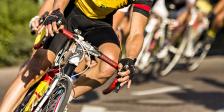Fitness Advice That Gets the Most Bang For Your Buck, Part 2
Learn more about the types of workouts, exercises, supplements, recovery strategies, and mental training that get you the most value for your money.
Ben Greenfield
Listen
Fitness Advice That Gets the Most Bang For Your Buck, Part 2

Nutrition
When it comes to nutrition, the first piece of advice is to increase whatever amount of vegetable and fruit you’re currently eating, with as much quantity and variety as possible. While I’m certainly a fan of eating plants, I do have one issue with this section of the article—the “lumping” of fruits and vegetables into the same category.
In fact, fruits and vegetables are two entirely different food groups. Fruit is “nature’s dessert,” and while it is a great source of nutrients and fiber, it is also high in fructose and calories when compared to vegetables. For example, I personally eat close to 20-25 servings of vegetables each day (yes, each day!), but only about one serving of fruit. This is because when I account for other carbohydrate sources, such as seeds, nuts, sweet potatoes, yams, and rice in my diet, the inclusion of excess fruit simply doesn’t allow me to maintain a lean body mass and stabilized blood sugar levels.
See also: Are Vegetables Better Than Fruit?
In addition, the article recommends a diet of around 50% carbohydrate, 20% fat, and 30% protein. While this is indeed a macronutrient ratio that falls in line with conventional sports nutrition guidelines, it’s important to realize that conventional sports nutrition guidelines don’t necessarily take into account the fact that athletes and individuals, who have been eating a slightly higher amount of healthy fats and lower amount of carbohydrates, may actually have developed glycogen (storage carbohydrate) conservation and fat burning mechanisms that allow for lower carbohydrate intake. This is a concept that I explore in great detail in my article about a high-fat diet and exercise study called “FASTER,” an effort in which I personally participated.
Alex also recommends an advanced nutritional technique called “train low,” in which overall carb intake remains high, but certain workouts are performed with low carbohydrate stores. This is achieved by either training before breakfast or depleting carb stores with periods of low carb intake.
This is a nutrition technique that I actually endorse and use nearly every day—plus, it’s super easy to implement. I simply save my entire carbohydrate intake for the very end of the day, and up until that point, I eat almost 0 carbohydrates, instead opting for a high amount of healthy fat and a moderate amount of protein. Then, within two-three hours after my afternoon workout, I eat anywhere from 100-200g of carbohydrates from sources such as red wine, dark chocolate, sweet potatoes, yams, or rice.
Finally, Alex cites some evidence that dehydration is a trigger that induces an increase in plasma volume, which in turn boosts endurance performance. He suggests that you may be able to take advantage of this by doing some of your training sessions in a slightly dehydrated state. While this may be a useful “biohack,” I’ve personally found that when doing a workout with a dry mouth or when feeling dehydrated, I’ve certainly experienced a dip in motivation and ability to reach a high level of exertion. This would be a strategy I’d reserve primarily for easier aerobic workouts and not use for tough training sessions.
Mental Training
Alex gives two pieces of advice in his section on mental training:
- See a sports psychologist.
- Avoid mental fatigue before competitions.

But there are a few other tricks you may want to bear in mind when it comes to mental training and motivation—tips I expound upon in my episode, “3 Jedi Mind Tricks to Improve Your Workouts”:
- Affirmation
- Visualization
- Breathing Techniques
Check out episode 225 for nitty-gritty details on these three techniques.
Race Prep
Alex gives a wealth of advice in the section on race prep, and whether you’re prepping for a 5K or an Ironman triathlon, these are tips that really do work, including:
- Taper: gradually dropping your exercise volume starting 2 weeks before your big event, with about 50% of normal volume in the last week, while maintaining intensity. I certainly agree with this concept, but with the caveat that I’ll often taper for just 4-5 days before many races, and only do a big, long taper before a very important event—like world championships. This is because multi-week tapers before an event can actually have the potential to detract from your fitness.
- Warm-up: a hard effort prior to a short, intense race or competition increases your VO2 max during the event. For example, Alex recommends a moderately hard, 6-minute effort, finishing 10 minutes before starting a cycling race, or 2, 60-second efforts, a little quicker than tempo pace, prior to starting a running race. I’m completely on board with this recommendation, and would also emphasize that for a warm-up, I’ve found a great deal of benefit from both visualization and hyperoxygenation breathing.
- Heat training: Alex recommends heat acclimation training (such as dry sauna) to boost performance, even in cool conditions. This can certainly be a good way to increase heat tolerance and blood plasma volume, and I get into the science of heat acclimation in my interview with Dr. Ronda Patrick. But in addition to heat training, I’d also emphasize the importance of cold training and cold thermogenesis for increasing cardiovascular efficiency and stress resilience. For any given week, I typically do at least a couple of 10-30 minute cold water immersion sessions and 30-45 minute dry sauna sessions (the latter of which, incidentally, is most effective post-workout).
While there are plenty more performance enhancing tips and tricks I could delve into, the takeaway message is this: by including just a few of these simple pieces of advice we’ve covered in the past 2 episodes, you can experience a bigger boost in performance than you’d get by just “training hard.”
Big thanks to Alex Hutchinson and Runner’s World for the original article that inspired me to write this 2 part series!
If you have more questions about the fitness advice that gets you the most bang for your buck, leave your thoughts over at the Facebook.com/GetFitGuy page!

